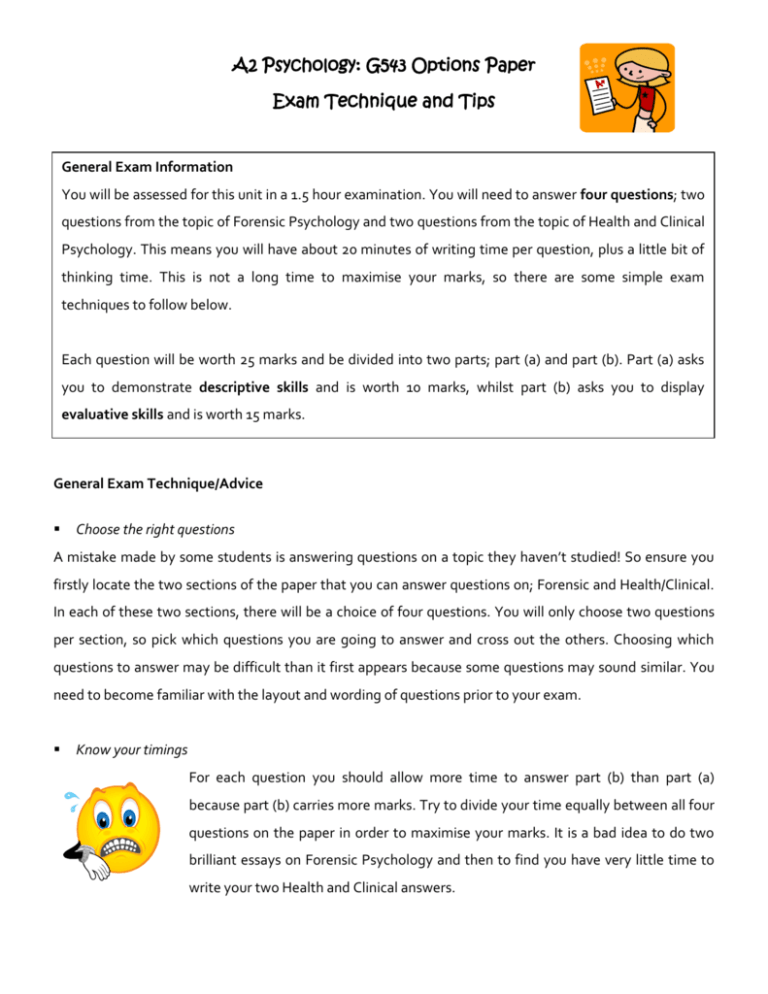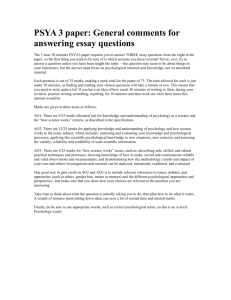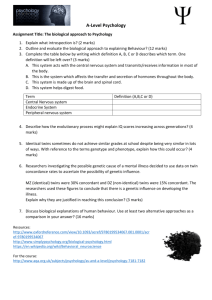A2 Forensic Psychology:
advertisement

A2 Psychology: G543 Options Paper Exam Technique and Tips General Exam Information You will be assessed for this unit in a 1.5 hour examination. You will need to answer four questions; two questions from the topic of Forensic Psychology and two questions from the topic of Health and Clinical Psychology. This means you will have about 20 minutes of writing time per question, plus a little bit of thinking time. This is not a long time to maximise your marks, so there are some simple exam techniques to follow below. Each question will be worth 25 marks and be divided into two parts; part (a) and part (b). Part (a) asks you to demonstrate descriptive skills and is worth 10 marks, whilst part (b) asks you to display evaluative skills and is worth 15 marks. General Exam Technique/Advice Choose the right questions A mistake made by some students is answering questions on a topic they haven’t studied! So ensure you firstly locate the two sections of the paper that you can answer questions on; Forensic and Health/Clinical. In each of these two sections, there will be a choice of four questions. You will only choose two questions per section, so pick which questions you are going to answer and cross out the others. Choosing which questions to answer may be difficult than it first appears because some questions may sound similar. You need to become familiar with the layout and wording of questions prior to your exam. Know your timings For each question you should allow more time to answer part (b) than part (a) because part (b) carries more marks. Try to divide your time equally between all four questions on the paper in order to maximise your marks. It is a bad idea to do two brilliant essays on Forensic Psychology and then to find you have very little time to write your two Health and Clinical answers. Example Exam Question and Mark Scheme Below is the marking criteria for the questions. Although this is for a question on jury decision making, the same criteria for each band will apply to ALL four questions that you will answer. Therefore, become familiar with the criteria in the top marking band and ensure all of your practice essays meet this criteria. Mark Scheme a) Describe relevant research which informs us about how a jury reaches its verdict. [10] Candidates are most likely to draw upon stages and influences on decision making (e.g. Hastie 1983), Majority influence (e.g. Asch 1953). Minority influence (e.g. Moscovici 1976, 1980, 1985) but any other relevant research should be credited. 0 marks – No or irrelevant answer. 1-2 marks – Psychological terminology is sparse or absent. Description of evidence is limited, mainly inaccurate and lacks detail. There is no interpretation or explanation of the evidence in the context of the question. The answer is unstructured and lacks organisation. Answer lacks grammatical structure and contains many spelling errors. 3-5 marks Psychological terminology is basic but adequate. Description of evidence is generally accurate and coherent, has peripheral relevance but lacks detail. Elaboration/use of example/ quality of description is reasonable but interpretation of the evidence in the context of the question is poor. The answer has some structure and organisation. The answer is mostly grammatically correct with some spelling errors. 6-8 marks – Psychological terminology is competent and mainly accurate. Description of evidence is mainly accurate and relevant, coherent and reasonably detailed. Elaboration/use of example/quality of description is good. There is some evidence of interpretation and explanation in the context of the question. The answer has good structure and organisation. The answer is mostly grammatically correct with few spelling errors. 9-10 marks – Correct and comprehensive use of psychological terminology. Description of evidence is accurate, relevant, coherent and detailed. Elaboration/use of example/quality of description is very good and the ability to interpret/explain the evidence selected in the context of the question is very good. The answer is competently structured and organised. Answer is mostly grammatically correct with occasional spelling errors. b) Discuss the problems of conducting research into courtroom behaviour. [15] Candidates would be expected to know that live courtroom research is illegal and therefore, mock or shadow juries have to be used. These lead to problems as does a straightforward laboratory study. Problems could be ethics, sampling, validity, reliability, demand characteristics, etc. 0 marks – No or irrelevant answer. 1-3 marks – Few evaluative points. Range of points is sparse. No evidence of argument. Points are not organised, and are of peripheral relevance to the context of the question. Sparse or no use of supporting examples. Limited or no valid conclusions that effectively summarise issues and arguments. 4-7 marks – Argument and organisation is limited, and some points are related to the context of the question. Limited evaluative points. Valid conclusions that effectively summarise issues and arguments is evident and demonstrates some understanding 8-11 marks – Some evaluative points covering a range of issues. The argument is well organised, but may lack balance or development, and is related to the context of the question. Good use of examples. Valid conclusions that effectively summarise issues and arguments is competent and understanding is good. 12-15 marks – Many evaluative points covering a range of issues. The argument is competently organised, balanced and well developed. The answer is explicitly related to the context of the question. Effective use of examples. Valid conclusions that effectively summarise issues and arguments is highly skilled and shows thorough understanding. How to Construct an Argument The mark scheme for part (b) questions includes comments about the quality of argument. To get into the top band, your argument must be ‘competently organised, balanced and well developed’. In addition, it should be ‘highly skilled’ and show ‘thorough understanding’. So, what does this look like? 1. Firstly make your claim/state your point. Samples used by researchers in the courtroom lack generalisability. 2. Then, give a reason for your claim/explain your point (because…) Because researchers use opportunity samples of their own students when carrying out their research. 3. Now, support your claim/point with evidence. For example, Moscovici used a sample of his own female students in his study into the effects of minority influence. 4. You can now provide further evaluative comment - evaluate the point you have made. This is problematic because the students may be gaining course credit by taking part and may therefore show demand characteristics by behaving in a way they think the researchers want. As they are mainly psychology students, they may also be able to work out the researcher’s aim. 5. Lastly, provide a counter argument to demonstrate a really thorough understanding (however…) However, researchers need the convenience of an opportunity sample to be able to complete their research in a reasonable time and against a limited budget. 6. Conclude. So caution would be needed when applying the findings to an actual courtroom situation. There are a number of ways that this claim/point could have been explained. However, the example above is intended to illustrate how an argument can be developed to demonstrate thorough understanding of a point. It is better to show a thorough understanding of say, three evaluative issues than to show a weak understanding of say, five. Sample Exam Questions – Forensic Psychology Turning to Crime (a) Describe using relevant evidence, any two influences which explain why a person turns to crime. [10] (b) Using the issue of reductionism, evaluate any two explanations of why a person may turn to crime. [15] (a) Outline a biological explanation of why males commit more crimes than females. [10] (b) To what extent does the biological approach provide an explanation of criminal behaviour? [15] (a) Outline on or more theories for why someone might turn to crime. [10] (b) Evaluate explanations of why some people turn to crime. [15] Making a Case (a) Outline any relevant research which can inform us about how a witness should be interviewed. [10] (b) Evaluate the methodology used to investigate the interviewing of witnesses. [15] (a) Outline relevant research into detecting the lies of suspects. [10] (b) Discuss the problems associated with the methods used to interview suspects. [15] (a) Describe one approach to offender profiling. [10] (b) Assess the effectiveness of offender profiling. [15] (a) Describe the bottom up approach to creating a profile. [10] (b) Assess the reliability of offender profiling. [15] Reaching a Verdict (a) Describe how a jury evaluates evidence in a criminal trial. [10] (b) Discuss the problems of conducting research into the behaviour of juries. [15] (a) Describe relevant research into the effects of shields and videotape on children giving evidence. [10] (b) Evaluate the methodology used to investigate witness appeal in criminal trials. [15] (a) Describe relevant research which informs us about how a jury reaches its verdict. [10] (b) Discuss the problems of conducting research into courtroom behaviour. [15] (a) Describe the stages involved in a jury reaching a verdict and the main influences on this process. [10] (b) Discuss the effect of majority and minority influence on decision-making in juries using relevant research. [15] After a Guilty Verdict (a) Identify the link between imprisonment and suicide. [10] (b) Evaluate the usefulness of research into the psychological effects of imprisonment. [15] (a) Describe relevant research which informs us about the effect of imprisonment on prison inmates. [10] (b) Evaluate the methodology used to investigate the impact of imprisonment. [15] (a) Describe the restorative justice approach to managing the impact of crime. [10] (b) Discuss the alternatives to imprisonment in controlling crime, using relevant research. [15] (a) Describe and evaluate one treatment or therapy used to treat criminal behaviour. [10] (b) Discuss the problems of conducting research into treatments for criminal behaviour. [15] Sample Exam Questions – Health and Clinical Psychology Healthy Living (a) Describe how Rosenstock’s Health Belief Model can be used to explain healthy behaviour. [10] (b) Compare and contrast two theories of health belief. [15] (a) Describe how one method of health promotion has been used. [10] (b) Review the effectiveness of health promotion methods. [15] (a) Outline how media campaigns can be used to promote healthy living. [10] (b) Describe and evaluate one other method of promoting healthy living. [15] (a) Describe one technique which could be used to measure adherence to medical regimes and give an example from a research study. [10] (b) Discuss problems psychologists might have when trying to improve adherence to medical regimes. [15] (a) Describe one way to measure non-adherence to medical advice. [10] (b) Assess the reliability of research into non-adherence to medical advice. [15] Stress (a) Describe one piece of research which considers work as a source of stress. [10] (b) Discuss problems of conducting research into the causes of stress. [15] (a) Outline the self-report method of measuring stress. [10] (b) Discuss and evaluate a combined approach to measuring stress, using relevant research. [15] (a) Outline a cognitive technique for managing stress. [10] (b) Compare techniques for managing stress. [15] Dysfunctional Behaviour (a) Outline how abnormal behaviour can be categorised. [10] (b) Discuss, using relevant research, how biases can impact on diagnosis. [15] (a) Outline a biological explanation for dysfunctional behaviour. [10] (b) Discuss, using relevant research, behavioural explanations for dysfunctional behaviour. [15] (a) Outline one approach to treating dysfunctional behaviour. [10] (b) Discuss the effectiveness of treatments for dysfunctional behaviour. [15] Disorders (a) Describe how biological treatments can be used to treat any one psychological disorder. [10] (b) Evaluate the use of biological treatments for psychological disorders. [15] (a) Outline one explanation of a psychological disorder of your choice. [10] (b) Evaluate explanations of a psychological disorder of your choice. [15] (a) Describe the characteristics of a psychotic disorder. [10] (b) Evaluate difficulties when identifying characteristics of psychological disorders. [15]








